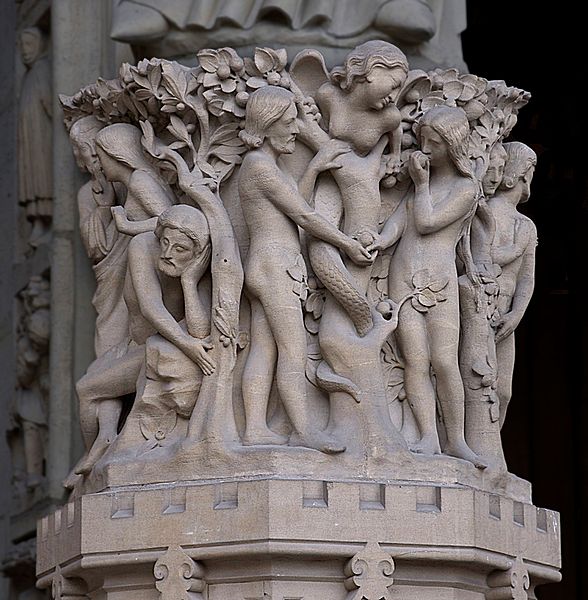In J. R. R. Tolkien's fantasy The Lord of the Rings, Old Man Willow is a malign tree-spirit of great age in Tom Bombadil's Old Forest, appearing physically as a large willow tree beside the River Withywindle, but spreading his influence throughout the forest. He is the first hostile character encountered by the Hobbits after they leave the Shire.
Old Man Willow, drawn by Tolkien while he was writing the chapter on the Old Forest. A face can just be made out on the right-hand side of the tree above the arm-like branch.
Tom Bombadil frees the Hobbits from Old Man Willow. Scraperboard illustration by Alexander Korotich, 1981
Tolkien may have based his drawing of Old Man Willow on a tree beside the River Cherwell in Oxford, like this one in the University Parks there.
Tolkien, a Roman Catholic, believed that living things such as trees had been affected by the Fall of Man. Medieval statuary of the Fall at Notre Dame de Paris
The Lord of the Rings is an epic high fantasy novel by the English author and scholar J. R. R. Tolkien. Set in Middle-earth, the story began as a sequel to Tolkien's 1937 children's book The Hobbit, but eventually developed into a much larger work. Written in stages between 1937 and 1949, The Lord of the Rings is one of the best-selling books ever written, with over 150 million copies sold.
Beowulf's eotenas [ond] ylfe [ond] orcneas, "ogres [and] elves [and] devil-corpses" helped to inspire Tolkien to create the Orcs and Elves of Middle-earth.
Barbara Remington's cover illustrations for the Ballantine paperback version "achieved mass-cult status" on American college campuses in the 1960s. They were parodied by Michael K. Frith's cover design for the 1969 Bored of the Rings.
"Welcome to Hobbiton" sign in Matamata, New Zealand, where Peter Jackson's film version was shot





![Beowulf's eotenas [ond] ylfe [ond] orcneas, "ogres [and] elves [and] devil-corpses" helped to inspire Tolkien to create the Orcs and Elves of Middle-e](https://upload.wikimedia.org/wikipedia/commons/thumb/c/cd/Beowulf_eotenas_ylfe_orcneas.jpg/640px-Beowulf_eotenas_ylfe_orcneas.jpg)

